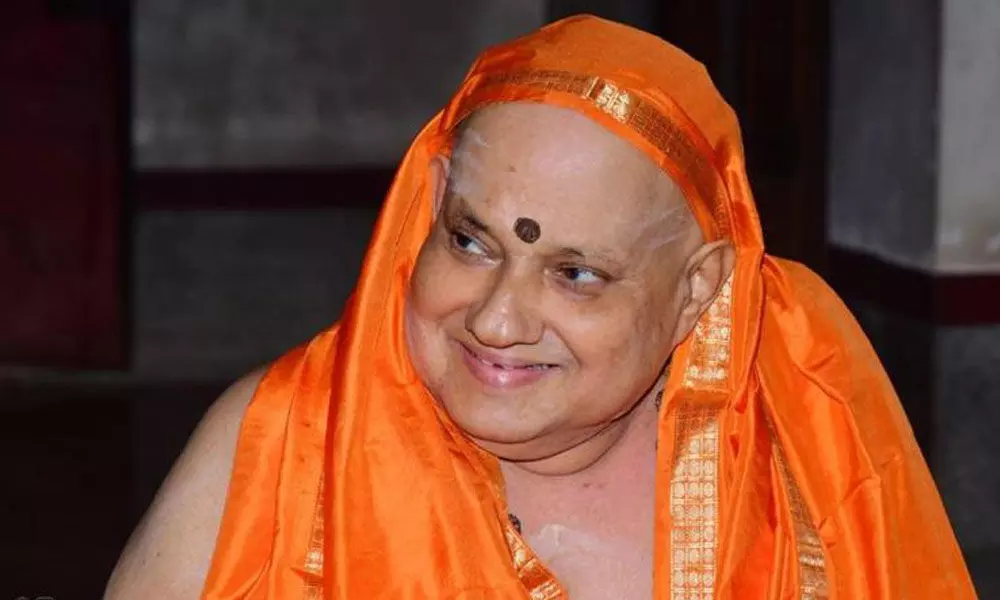Live
- Tirupati: SP seeks public cooperation to check crimes
- State govt committed to protect Wakf lands: Shariff
- Tirupati: 8 held; 69 red sanders logs seized
- Govt Schemes: Take steps to achieve loan targets says Collector to pvt banks
- Consumer rights protection is a shared social responsibility
- High Court relief for KCR, Harish Rao
- Visakhapatnam: Class VIII boy allegedly commits suicide
- Ram Mohan calls for collective efforts to develop dist
- Convocation ceremony held at ICBM-SBE
- Visakhapatnam: Webinar on web services skills on Dec 28
Just In
Kesavananda Bharati: A true Karma Yogi


Kesavananda Bharati
Kesavananda Bharati, the seer of the Edneer Mutt in Kerala and the petitioner in the landmark judgment of the Supreme Court on fundamental rights, passed away in the early hours of September 6
Kesavananda Bharati, the seer of the Edneer Mutt in Kerala and the petitioner in the landmark judgment of the Supreme Court on fundamental rights, passed away in the early hours of September 6. He was 80. He has headed the Mutt since 1961. Apart from being a proponent of the Advaita philosophy, the seer was a good classical singer. He ran a 'Yakshagana mela' (troupe) for nearly 15 years and took part as a 'bhagavata' (singer and director), rendering Carnatic music. He also conducted literary programmes in the Mutt.
But he will be forever remembered in India as the main petitioner in the landmark case that changed the course of the country's constitutional law. How is he different from other Mutt heads or Swamijis? Well, he was the petitioner in the historic Supreme Court case 'Kesavananda Bharati vs. State of Kerala (1973)' which introduced the basic structure doctrine of the Constitution by a wafer-thin majority of 7-6. The case was instrumental in safeguarding the democratic values the Constitution protects.
The apex court ruled in the Bharati case in 1973 that the Parliament has only limited powers to amend the basic constitutional structure. Kesavananda Bharati had little idea that the case he filed would end up being such a landmark. Taking umbrage at the Kerala government's attempt to impose restrictions on the management of religious property through land reform legislation, Bharati filed the suit questioning its constitutional propriety. The case came to the attention of Nani Palkhivala, who recognised its possibilities, particularly the prospect of challenging three Amendments — the 24th, 25th and 26th — to the Constitution. The case continues to be the longest hearing ever to have taken place in the Supreme Court. It was heard for 68 days. Hearing in the Kesavananda Bharati case commenced on October 31, 1972, and concluded on March 23, 1973. This case was followed by the Ayodhya dispute, in terms of the number of days argued before the Supreme Court.
The 'basic structure' doctrine has since been interpreted to include the supremacy of the Constitution, the rule of law, Independence of the judiciary, the doctrine of separation of powers, federalism, secularism, sovereign democratic republic, the parliamentary system of government, the principle of free and fair elections and the indispensability of the welfare state. Despite all this, it became a butt of ridicule of the critics who termed it undemocratic, since it allowed "unelected judges" to strike down constitutional amendments.
But for many it was a safeguard against majoritarianism and authoritarianism. The genesis of the dispute leading to Kesavananda Bharati case is in the interpretation of Article 368 of the Indian Constitution, which allows Parliament to amend the Constitution. There is no ambiguity in the Article itself. The dispute was with the scope and extent of Parliamentary power to modify the Constitution vis a vis the fundamental rights.
Then came the nationalisation of banks and later abolition of Privy Purses etc. which resulted in the Constitutional amendments. Parliament's attempts to amend the Constitution led to the Kesvananda Bharati case. His life is a shining example for the seers and sanyasis that such lives are meant to serve the larger public good. Kesavananda Bharati's 'paramapada' is a great loss to the nation. He was a true Karma Yogi!

© 2024 Hyderabad Media House Limited/The Hans India. All rights reserved. Powered by hocalwire.com






